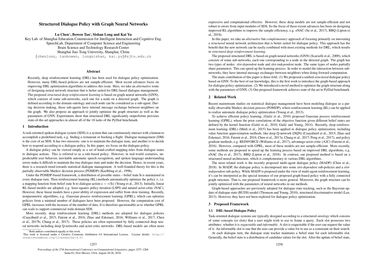Structured Dialogue Policy with Graph Neural Networks
Recently, deep reinforcement learning (DRL) has been used for dialogue policy optimization. However, many DRL-based policies are not sample-efficient. Most recent advances focus on improving DRL optimization algorithms to address this issue. Here, we take an alternative route of designing neural network structure that is better suited for DRL-based dialogue management. The proposed structured deep reinforcement learning is based on graph neural networks (GNN), which consists of some sub-networks, each one for a node on a directed graph. The graph is defined according to the domain ontology and each node can be considered as a sub-agent. During decision making, these sub-agents have internal message exchange between neighbors on the graph. We also propose an approach to jointly optimize the graph structure as well as the parameters of GNN. Experiments show that structured DRL significantly outperforms previous state-of-the-art approaches in almost all of the 18 tasks of the PyDial benchmark.
PDF Abstract COLING 2018 PDF COLING 2018 Abstract


